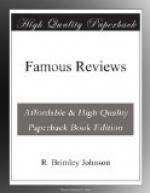The moral systems of the two cycles are essentially allied: and perhaps the differences between them may be due in greater or in less part to the fact that they come to us through different media. We of the nineteenth century read the Carlovingian romance in the pages of Ariosto and Bojardo, who gave to their materials the colour of their times, and of a civilization rank in some respects, while still unripe in some others. The genius of poetry was not at the same period applying its transmuting force to the Romance of the Round Table. The date of Sir Thomas Mallory, who lived under Edward IV, is something earlier than that of the great Italian romances; he appears, too, to have been on the whole content with the humble offices of a compiler and a chronicler, and we may conceive that his spirit and diction are still older than his date. The consequence is, that we are brought into more immediate and fresher contact with the original forms of this romance. So that, as they present themselves to us, the Carlovingian cycle is the child of the latest middle age, while the Arthurian represents the earlier. Much might be said on the differences which have thus arisen, and on those which may be due to a more northern and more southern extraction respectively. Suffice it to say that the Romance of the Round Table, far less vivid and brilliant, far ruder as a work of skill and art, has more of the innocence, the emotion, the transparency, the inconsistency of childhood. Its political action is less specifically Christian than that of the rival scheme, its individual more so. It is more directly and seriously aimed at the perfection of man. It is more free from gloss and varnish; it tells its own tale with more entire simplicity. The ascetic element is more strongly, and at the same time more quaintly, developed. It has a higher conception of the nature of woman; and like the Homeric poems, appears to eschew exhibiting her perfections in alliance with warlike force and exploits. So also love, while largely infused into the story, is more subordinate to the exhibition of other qualities. Again, the Romance of the Round Table bears witness to a more distinct and keener sense of sin: and on the whole, a deeper, broader, and more manly view of human character, life, and duty. It is in effect more like what the Carlovingian cycle might have been had Dante moulded it. It hardly needs to be added that it is more mythical, inasmuch as Arthur of the Round Table is a personage, we fear, wholly doubtful, though not impossible; while the broad back of the historic Charlemagne, like another Atlas, may well sustain a world of mythical accretions. This slight comparison, be it remarked, refers exclusively to what may be termed the latest “redactions” of the two cycles of romance. Their early forms, in the lays of troubadours, and in the pages of the oldest chroniclers, offer a subject of profound interest, and one still unexhausted, although it has been examined by Mr. Panizzi and M. Fauriel,[1] but one which is quite beyond the scope of our present subject.




